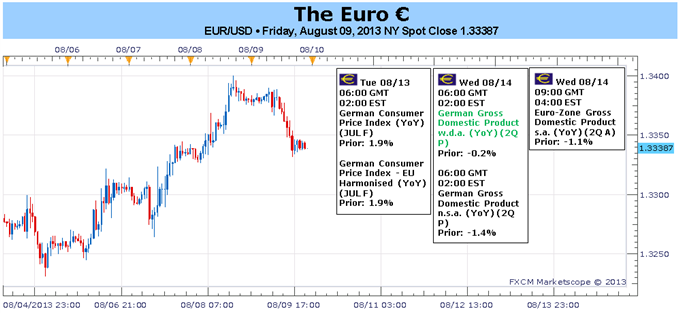
Fundamental Forecast for Euro: Bearish
Euro and Pound Maintain Gains as US Dollar Hits Two-Month Low
Euro Sentiment at Records as EURUSD Surges – What’s Next?
US Dollar at Make-or-Break Levels versus Euro, British Pound
The Euro was the second worst performer last week, appreciating by only a mere +0.49% against the beleaguered US Dollar (with the EURUSD closing at $1.3342). Losses were steep elsewhere, especially against the Asian-Pacific currencies: the EURAUD tumbled by -2.87% to A$1.4492; and the EURJPY slid by -2.33% to ¥128.39. This type of price action – indiscriminate selling versus risk and safe haven currencies alike – suggests that there may be greater troubles ahead.
Certainly, it is a far reach to suggest that the fundamentals are provoking the recent slide. True, the Euro-Zone’s main problem, labor markets across major economies at their weakest levels ever, has yet to be resolved.
Since mid-May, though, the tone has been dramatically different: stronger PMI figures from Germany, France, Italy, and Spain; improved price gauges that suggests demand may slowly be returning to periphery countries; and relatively less volatility in bond markets thanks to more stable/less dramatic political regimes in Italy and Spain.
These improved data and themes have had a varying impact on European financial instruments. The main European stock indexes have rallied sharply since mid-June (the German DAX is up by +8.91% since the June 24 low,while the Spanish IBEX is up by +16.34% over the same period) and peripheral bond yields have remained low (the Italian 2-year note yield has dropped from 2.255% on June 24 to 1.765% on Friday’s close, while the Spanish 2-year note yield has dropped from 2.552% to 1.797% over the same period; bond yields move inverse to price).
It has been an entirely different story for the Euro. The EURUSD has appreciated by +1.86% over the same period, while the EURJPY – perhaps the best ‘true’ barometer of European FX risk demand – is only up by a measly +0.02%. One possible explanation for this may be concern over growth momentum, first noted by European Central Bank President Mario Draghi at the August policy meeting press conference.
A main concern for ECB President Draghi was that, despite the near-term upswing in regional growth data, credit growth remains exceptionally low. The inference is that if credit growth struggles, the Euro-Zone economy will have difficultly gaining momentum; lending is crucial to expanding economic activity.
A look at Euro-Zone excess liquidity shows that capital levels have fallen back to pre-LTRO1 levels, which of course precipitated liquidity injections totaling over €1 trillion beginning between December 21, 2011 and February 29, 2012. So, while the ECB may not want to cut rates again given the near-term pick-up in growth prospects, it may be thinking about implementing another liquidity injection to help spur credit growth.
If the market is beginning to position itself for such a small policy shift, the financial classes previously discussed are behaving as they should under such a scenario: additional liquidity spurs investors to seek return – drive equity markets higher (check); buy those assets implicitly targeted by the ECB vis-à-vis these operations – peripheral debt, which would drive yields lower (check); and a Euro that struggles to appreciate against its major counterparts despite signs of improved regional economic activity (check).
Thus, for the week ahead, we are not paying so much attention to the data as much as we are to the reaction to the data; if the Euro is indeed shrugging off improved growth prospects (“priced in”), then the expected signs of further improvement in Germany shouldn’t matter much. If such a scenario plays out, it may be the sign of broader Euro weakness readying to set in. –CV
DailyFX provides forex news and technical analysis on the trends that influence the global currency markets.Learn forex trading with a free practice account and trading charts from FXCM.
Source: Daily fx